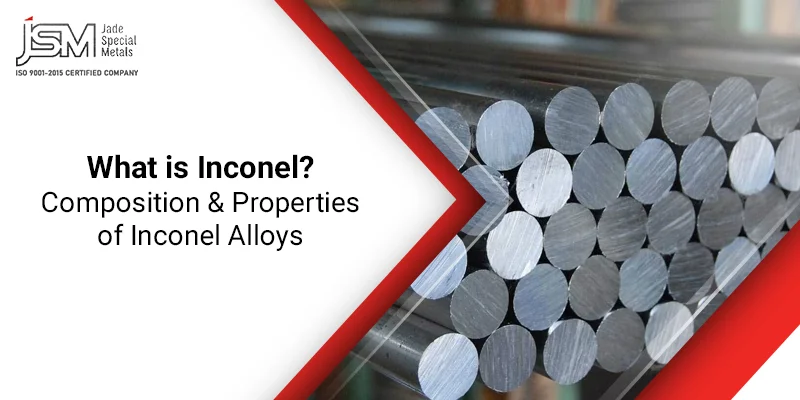When you look at nickel alloys and superalloys, Inconel is usually the first name that comes up. It is one of the most widely used superalloys. If you plan to specify this alloy for your project, it’s important to understand how it behaves in service.
This guide explains what Inconel is and gives a clear overview of its key aspects, chemical composition, mechanical properties, and physical properties.
What is Inconel?
Inconel is a family of alloys developed by Special Metals. These alloys are valued for their strong resistance to high temperatures and corrosion. Based on different inconel composition ratios, the family includes multiple grades tailored to specific environments. One of the earliest grades, Inconel X-750, dates back to 1943.
Chemical composition of Inconel alloys
Nickel and chromium
In Inconel, nickel drives high-temperature stability while chromium delivers corrosion and oxidation resistance. The balance between these two in the inconel composition sets the performance focus. A higher Ni:Cr ratio favors heat resistance; a higher chromium share improves corrosion behavior.
Example: Inconel 600 contains about 72% Ni and around 14% Cr, so it performs better at elevated temperatures than Inconel 690. Inconel 690, with roughly 58% Ni and about 28–31% Cr, offers superior corrosion resistance compared to 600. These differences highlight how inconel alloy composition is tuned for specific service conditions.
Molybdenum
Chromium protects well in many oxidizing environments, but it does not cover everything. Adding molybdenum fills those gaps, strengthening resistance in reducing and chloride-rich conditions and also increasing alloy strength. Nickel-chromium-molybdenum grades such as Inconel 625 show broader, more robust corrosion resistance in complex media than Inconel 600.
Niobium, cobalt, and tungsten
Beyond Cr and Mo, other elements tailor properties further.
- Niobium in Inconel 625 contributes to higher strength through solid-solution strengthening.
- Cobalt in Inconel 617 supports strength retention at higher temperatures, improving creep resistance compared with 625 in very hot service.
- Tungsten in Inconel 686 raises strength and enhances resistance to pitting, adding another layer of protection in aggressive environments.
Together, these element choices and their proportions define the inconel composition and explain why different grades are selected for different operating demands.
Mechanical properties of Inconel alloys
Inconel grades are broadly grouped by microstructure into two families: solid-solution-strengthened and precipitation-strengthened. Precipitation-strengthened grades deliver much higher strength, which is why the family is split into multiple grades for different needs. If your design demands very high strength, choose a precipitation-strengthened alloy. Solid-solution grades offer wide options when you need a balance of properties, corrosion resistance, or formability based on inconel composition.
Solution hardened Inconel alloys
These alloys are essentially single-phase, with strength coming from inconel alloy composition and any cold work. In the Inconel family, grades starting with “6” are typically solid-solution strengthened, for example Inconel 600 and Inconel 625. Elements with strong solution-strengthening effects such as Mo, W, Nb, and Co raise strength. Beyond that, further gains are achieved by cold working.
Typical room-temperature mechanical properties
| Alloy | Tensile strength (MPa) | Yield strength (MPa) | Elongation (%) |
| Inconel 600 | 550 | 240 | 30 |
| Inconel 601 | 550 | 205 | 30 |
| Inconel 617 | 655 | 240 | 35 |
| Inconel 625 | 690 | 276 | 30 |
Precipitation-strengthened Inconel alloys
Grades beginning with “7” such as Inconel 718 and Inconel X-750 are multiphase alloys that harden by forming fine precipitates. Key elements include Al, Ti, Nb, and Ta, which create strengthening phases during heat treatment. After solution treatment and aging, and often combined with prior cold work, these alloys achieve very high strength.
Typical room-temperature mechanical properties
| Alloy | Tensile strength (MPa) | Yield strength (MPa) | Elongation (%) |
| Inconel 718 | 1275 | 1034 | 12 |
| Inconel 725 | 1137 | 827 | 20 |
| Inconel X-750 | 1170 | 790 | 15 |
Note: Actual values vary with product form, heat treatment, and specification. Always confirm with the relevant data sheet for your selected Inconel grade and inconel composition.
Physical and Thermal Properties of Inconel Alloys
Density is the real concern when it comes to physical properties of Inconel alloys. Because the chemical makeup varies by grade, their densities differ, and that number drives weight calculations; using a generic value can push estimates far from reality. Typical Inconel grades are about 8.2 to 8.5 g/cm³, with melting ranges around 1260 to 1413 °C. Thermal conductivity is modest, about 10 W/m·K at room temperature and rising with heat. The coefficient of thermal expansion is roughly 12 to 14 µm/m·°C, specific heat about 0.41 to 0.45 J/g·°C, and the elastic modulus is near 200 GPa at room temperature, decreasing as temperature increases. Together, these physical and thermal traits deliver predictable dimensional stability and strong oxidation resistance in hot, corrosive service.
Industrial Applications of Inconel Alloys
With a Ni–Cr backbone in the inconel alloy composition, these superalloys combine high-temperature strength with excellent corrosion resistance. Here are five core industries where Inconel proves its value.
1) Aerospace & jet engines- Hot sections face high stress, oxidation, and creep. Inconel parts keep strength and dimensional stability. Typical uses: lockwire, exhaust liners, turbine seals (e.g., Inconel 600), and broader airframe/engine hardware where Inconel 601 offers high strength and good workability.
2) Oil & gas extraction- Equipment sees sour media, chlorides, and severe thermal cycles. Inconel 625 is common in LNG processing and sour-gas service (liners, cladding, transfer piping) thanks to fatigue and thermal-fatigue strength, oxidation resistance, high tensile/creep/rupture strength, and solid weldability driven by its inconel composition.
3) Pollution control & waste processing- Systems handle oxidizing/reducing acids and high temperatures. Nickel–molybdenum–chromium alloys such as C-276 are used for pitting/crevice corrosion resistance; low carbon helps limit carbide precipitation during welding, preserving corrosion performance in as-welded structures.
4) Automotive (performance systems)- Powertrain components demand heat resistance, reliability, and lower weight. Inconel 625 appears in exhaust couplings and hot-zone parts; Inconel grades also show up in ignition components, sensors, safety devices, and switchgear for durability under heat.
5) Marine industry- Seawater accelerates corrosion; chloride resistance is critical. Inconel 625 serves in wire rope, propeller blades, propulsion motors, and undersea cable sheathing. Across platforms, Inconel also supports down-hole tools, risers, hangers, and high-strength fasteners where the inconel alloy composition resists localized attack.
Trusted Inconel Alloys Supplier in India
If you need reliable Inconel for demanding service, choose Jade Alloys. We stock and source popular grades such as 600, 601, 601GC, 617, 625, 686, 690, 718, 725, 740H, X-750, 751 and 783 in pipes, tubes, sheets, plates, bars and fittings. Our team helps you match inconel composition to operating conditions, so the inconel alloy composition you pick delivers the strength, corrosion resistance and temperature stability your application requires.
Jade Alloys is ready to support your project with technical guidance, competitive pricing and dependable supply. Request a quote or share your specifications to get started.






